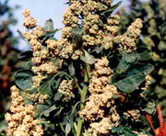Quinoa: One of the world's most perfect foods

Its origin
Quinoa (pronounced "keenwa") has grown in the South American Andes for thousands of years, and thrives in high, cold altitudes. The Incas dubbed quinoa the 'mother grain' because of the plant's ever-bearing quality. They also believed the kernels to be sacred, since a steady diet of it appeared to ensure a long, healthy life.
What it is and what it looks like
Although known as a grain, Quinoa is technically a fruit. Its small nutritious seeds resemble millet.
Nutritional content
Compared with other grains, it has the highest protein. Its protein is also a better quality than that of meat.
Low in fat and the majority of its oil is polyunsaturated, providing essential fatty acids.
Provides more calcium than milk and four times as much as wheat. It is also a very good source of iron as well as phosphorous, copper, magnesium, manganese, potassium and zinc. It contains B and E vitamins.
Its Versatility
Can be eaten as a rich replacement for rice, hot breakfast cereal; sprinkled on muesli, a nutritional thickener for soups, croquettes, tabouleh, casseroles, desserts and more!
To get the most from quinoa's iron and minerals, combine it with vitamin C-rich veggies such as peppers, greens, broccoli and asparagus. It also goes with other lean protein sources, such as legumes, fish, meat or poultry.
Can be ground into flour and used in baking breads and cakes. Because it is gluten-free, it is suitable for anyone afflicted by wheat allergies.
How to prepare it
Because Quinoa seeds are naturally coated with a bitter-tasting saponin that protects it from birds and insects they should be well-rinsed.
To cook:
Add twice as much water, bring to the boil and simmer for 20 minutes.
Where it can be bought
Healthfood stores. Can be bought as seeds; flakes or a crunchy cereal.
Recipe: Quinoa Pilaf with chickpeas and dried fruits
from The Optimum Nutrition CookBook by Patrick HolfordIngredients (serves 2)
- 1 teaspoon extra-virgin olive oil
- 1 medium onion, peeled and coarsely chopped 2 small sticks celery, trimmed and chopped
- 2 small leeks, trimmed and chopped
- 125g (4oz) canned chickpeas (drained weight) 1 stick of cinnamon
- 4 cardamom pods
- 100g (31/2OZ) quinoa
- 250ml (9fl oz) vegetable stock or water
- 25g (1 oz) sunflower seeds
- 25g (1 oz) raisins
- 6 prunes
- grated zest of 1/2 lemon
- some freshly chopped parsley
Method :
1. Brush the base of a deep non-stick frying pan with the oil. Add the onion. celery and leeks to the pan and cook gently for about 3 minutes to release the flavours. Keep the vegetables on the move with a wooden spoon and do not allow them to brown.
2. Add the chickpeas, spices, quinoa and vegetable stock or water to the mixture in the and stir. Bring to the boil, cover the pan and cook over a low heat for 10 minutes.
3. Add the sunflower seeds, raisins, prunes and lemon zest, and continue cooking for another 10 minutes until all the liquid has been absorbed and the quinoa is cooked through.
4. Pile the pilaf onto two serving plates, tossing gently to separate the grains. Sprinkle with plenty of freshly chopped parsley and serve at once.